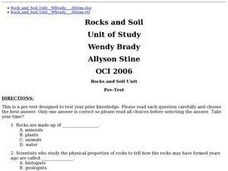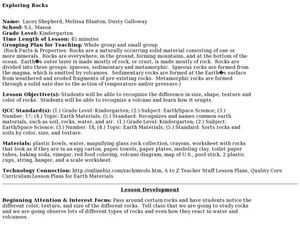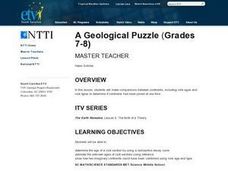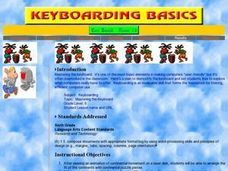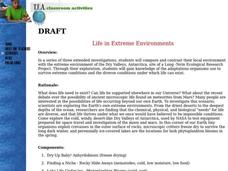Teach Engineering
Ranking the Rocks for Desired Properties
Math rocks! Cavern design teams determine the rankings of rock types based upon desirability points. The points are connected to the properties of the rocks and their usefulness in building a cavern.
Curated OER
Rocks and Minerals
Review the difference between rocks and minerals using this resource. Learners identify and investigate the physical properties of these objects. They create a Venn diagram to compare and contrast types of rocks. This is a motivating way...
Curated OER
Rocks and Soil
Middle schoolers explore the physical properties of rocks. They explore the three different types of rocks and are able to compare and contrast their different properties. Students simulate the creation of sedimentary rock, they also...
Curated OER
What on Earth is in the Earth?
Students explore the physical properties of sand, soil, and rocks and sort, classify, compare, and contrast the materials found in the soil. The differences between the living and non-living parts of the soil is discussed.
Curated OER
Rocks
Students use their five senses to experience different types of rocks. In groups, they compare and contrast the information they collected. They observe rocks in their local community and describe their uses to the class.
Curated OER
Rock vs. Mineral - Lesson #1
Students describe visual, textural, and other physical qualities of sample rock specimens. Using compare and contrast skills, students sort and classify the specimens according to their assessments of the qualities present in each....
Curated OER
Gettysburg Rocks Recycle to Win
Eighth graders use a geologic cross section to study the rock cycle of the Gettysburg battlefield. For this rock cycle lesson, 8th graders connect the rock cycle and continental rifting.
Curated OER
Rocks and Minerals
Fifth graders examine different types of rocks and classify rocks by their different characteristics. In small groups they sort their rocks into two categories, then create three categories to sort by on a sorting worksheet. Next, they...
Curated OER
Exploring Rocks
Pupils collect and examine rocks. They record information about the rocks they have collected in their notebooks. They compare and contrast different rocks and complete a class chart at the end of the lesson.
Curated OER
A Geological Puzzle
Students compare and contrast the various types of rocks on each continent. In groups, the calculate the rock ages and types to determine if the continents, in their opinion, were joined at one time. They develop two imaginary...
Curated OER
Art and Culture
Students compare and contrast the ways in which human figures are portrayed in rock art made by ancient Native American artists and in the drawings and paintings of historic European and American artists. They use images to identify...
Curated OER
Rock Identification Lab
Eighth graders compare and contrast the three different types of rock. In this earth science instructional activity, 8th graders classify rock samples according to their correct rock type. They design their own data collection table.
Curated OER
Forecasting the Path of Mudflows
Students watch a demonstration to introduce them to the consistency of mudflows and how they move. In groups, they compare and contrast volcanic avalanches and mudflows. They create their own model of a volcano, simulate how it erupts...
Curated OER
Classification and Attributes
Students classify objects based on their attributes. They explain how archaeologists use classification to help answer research questions.
Curated OER
Solids in the Playground
First graders locate and identify solids in the schoolyard. In this geometric solids lesson plan, 1st graders locate two solids on the playground. They work as a group to compare and contrast them according to shape, texture, weight,...
Curated OER
Mastering the Keyboard
Sixth graders view an animated program showing how the continents fit together millions of years ago. In groups, they compare and contrast the distribution of rocks and fossils based on how the continents fit together. After reading a...
Curated OER
Exploring Meteorite Mysteries: Building Blocks of Planets
Students simulate the formation of chondrites and asteroids. In this astronomy lesson plan, students demonstrate accretion using balloons and static electricity. They compare and contrast their models to the actual process of chondrites...
Curated OER
Microbial Influence on Earth's Systems
Students identify the different biogeochemical cycles on Earth. In this biology lesson, students observe microbes under a microscope. They compare and contrast respiration and photosynthesis.
Curated OER
What is the Evidence for Evolution?
Middle schoolers identify one object that would tell the story of their lives. In groups, they determine what can and cannot be told from objects left behind. After watching a video, they compare and contrast chicken bones to human...
Curated OER
Friction
Students compare and contrast the movement of objects on different surfaces, experimenting with friction and forces of motion. This friction lesson has numerous online tools including worksheets and virtual activities; the option is also...
Curated OER
Themes to Encourage Awareness of Environmental Changes on the Shoreline of Connecticut in Elementary School Students: The Case of Kelsey Island
Students begin the lesson by developing a map of Kelsey Island by following specific instructions. In groups, they are given a block of ice in which they tie a rope around and drag over various rocks for different distances. They...
Curated OER
Life in Extreme Environments
High schoolers compare and contrast local environments with the extreme environment of the Dry Valleys, Antarctica. Students explore and gain knowledge of the adaptations organisms use to survive extreme conditions and the diverse...
Curated OER
Regolith Formation
Students compare and contrast the process of regolith formations. In groups, students define regolith and discover how regolith is formed on the Earth and on the Moon. They participate in experimental activities to simulate regolith.
Curated OER
Respect the Beach
Students work together to compare and contrast sand particles. They identify what sand grains are composed of as well. They complete writing activities to complete the lesson.




